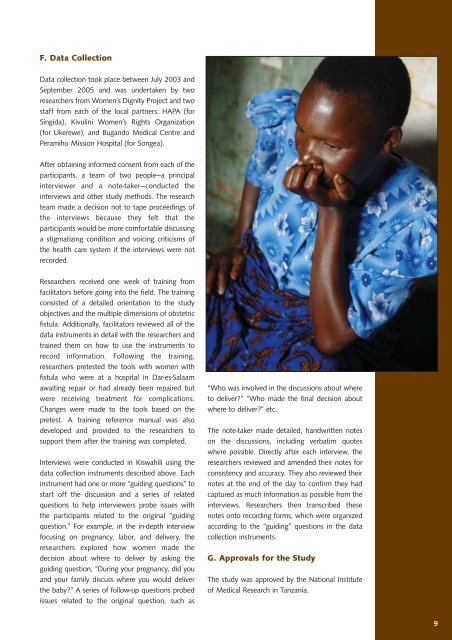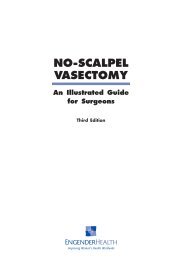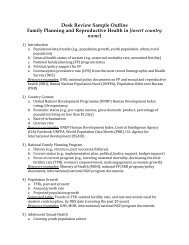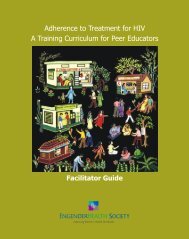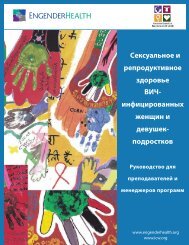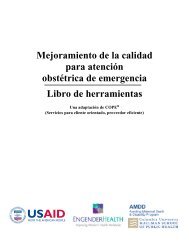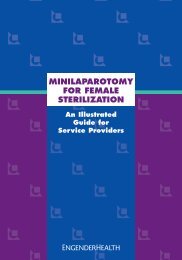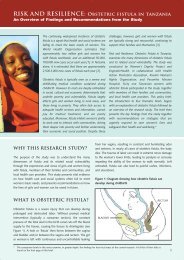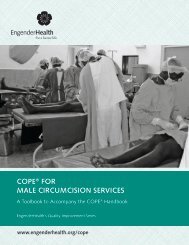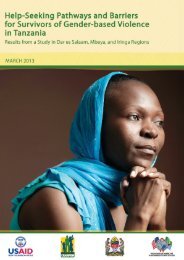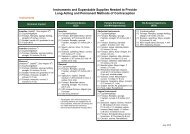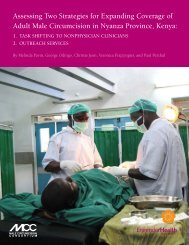Risk and Resilience: Obstetric Fistula in Tanzania - EngenderHealth
Risk and Resilience: Obstetric Fistula in Tanzania - EngenderHealth
Risk and Resilience: Obstetric Fistula in Tanzania - EngenderHealth
Create successful ePaper yourself
Turn your PDF publications into a flip-book with our unique Google optimized e-Paper software.
F. Data Collection<br />
Data collection took place between July 2003 <strong>and</strong><br />
September 2005 <strong>and</strong> was undertaken by two<br />
researchers from Women’s Dignity Project <strong>and</strong> two<br />
staff from each of the local partners: HAPA (for<br />
S<strong>in</strong>gida), Kivul<strong>in</strong>i Women’s Rights Organization<br />
(for Ukerewe), <strong>and</strong> Bug<strong>and</strong>o Medical Centre <strong>and</strong><br />
Peramiho Mission Hospital (for Songea).<br />
After obta<strong>in</strong><strong>in</strong>g <strong>in</strong>formed consent from each of the<br />
participants, a team of two people—a pr<strong>in</strong>cipal<br />
<strong>in</strong>terviewer <strong>and</strong> a note-taker—conducted the<br />
<strong>in</strong>terviews <strong>and</strong> other study methods. The research<br />
team made a decision not to tape proceed<strong>in</strong>gs of<br />
the <strong>in</strong>terviews because they felt that the<br />
participants would be more comfortable discuss<strong>in</strong>g<br />
a stigmatiz<strong>in</strong>g condition <strong>and</strong> voic<strong>in</strong>g criticisms of<br />
the health care system if the <strong>in</strong>terviews were not<br />
recorded.<br />
Researchers received one week of tra<strong>in</strong><strong>in</strong>g from<br />
facilitators before go<strong>in</strong>g <strong>in</strong>to the field. The tra<strong>in</strong><strong>in</strong>g<br />
consisted of a detailed orientation to the study<br />
objectives <strong>and</strong> the multiple dimensions of obstetric<br />
fistula. Additionally, facilitators reviewed all of the<br />
data <strong>in</strong>struments <strong>in</strong> detail with the researchers <strong>and</strong><br />
tra<strong>in</strong>ed them on how to use the <strong>in</strong>struments to<br />
record <strong>in</strong>formation. Follow<strong>in</strong>g the tra<strong>in</strong><strong>in</strong>g,<br />
researchers pretested the tools with women with<br />
fistula who were at a hospital <strong>in</strong> Dar-es-Salaam<br />
await<strong>in</strong>g repair or had already been repaired but<br />
were receiv<strong>in</strong>g treatment for complications.<br />
Changes were made to the tools based on the<br />
pretest. A tra<strong>in</strong><strong>in</strong>g reference manual was also<br />
developed <strong>and</strong> provided to the researchers to<br />
support them after the tra<strong>in</strong><strong>in</strong>g was completed.<br />
Interviews were conducted <strong>in</strong> Kiswahili us<strong>in</strong>g the<br />
data collection <strong>in</strong>struments described above. Each<br />
<strong>in</strong>strument had one or more “guid<strong>in</strong>g questions” to<br />
start off the discussion <strong>and</strong> a series of related<br />
questions to help <strong>in</strong>terviewers probe issues with<br />
the participants related to the orig<strong>in</strong>al “guid<strong>in</strong>g<br />
question.” For example, <strong>in</strong> the <strong>in</strong>-depth <strong>in</strong>terview<br />
focus<strong>in</strong>g on pregnancy, labor, <strong>and</strong> delivery, the<br />
researchers explored how women made the<br />
decision about where to deliver by ask<strong>in</strong>g the<br />
guid<strong>in</strong>g question, “Dur<strong>in</strong>g your pregnancy, did you<br />
<strong>and</strong> your family discuss where you would deliver<br />
the baby” A series of follow-up questions probed<br />
issues related to the orig<strong>in</strong>al question, such as<br />
“Who was <strong>in</strong>volved <strong>in</strong> the discussions about where<br />
to deliver” “Who made the f<strong>in</strong>al decision about<br />
where to deliver” etc.<br />
The note-taker made detailed, h<strong>and</strong>written notes<br />
on the discussions, <strong>in</strong>clud<strong>in</strong>g verbatim quotes<br />
where possible. Directly after each <strong>in</strong>terview, the<br />
researchers reviewed <strong>and</strong> amended their notes for<br />
consistency <strong>and</strong> accuracy. They also reviewed their<br />
notes at the end of the day to confirm they had<br />
captured as much <strong>in</strong>formation as possible from the<br />
<strong>in</strong>terviews. Researchers then transcribed these<br />
notes onto record<strong>in</strong>g forms, which were organized<br />
accord<strong>in</strong>g to the “guid<strong>in</strong>g” questions <strong>in</strong> the data<br />
collection <strong>in</strong>struments.<br />
G. Approvals for the Study<br />
The study was approved by the National Institute<br />
of Medical Research <strong>in</strong> <strong>Tanzania</strong>.<br />
9


